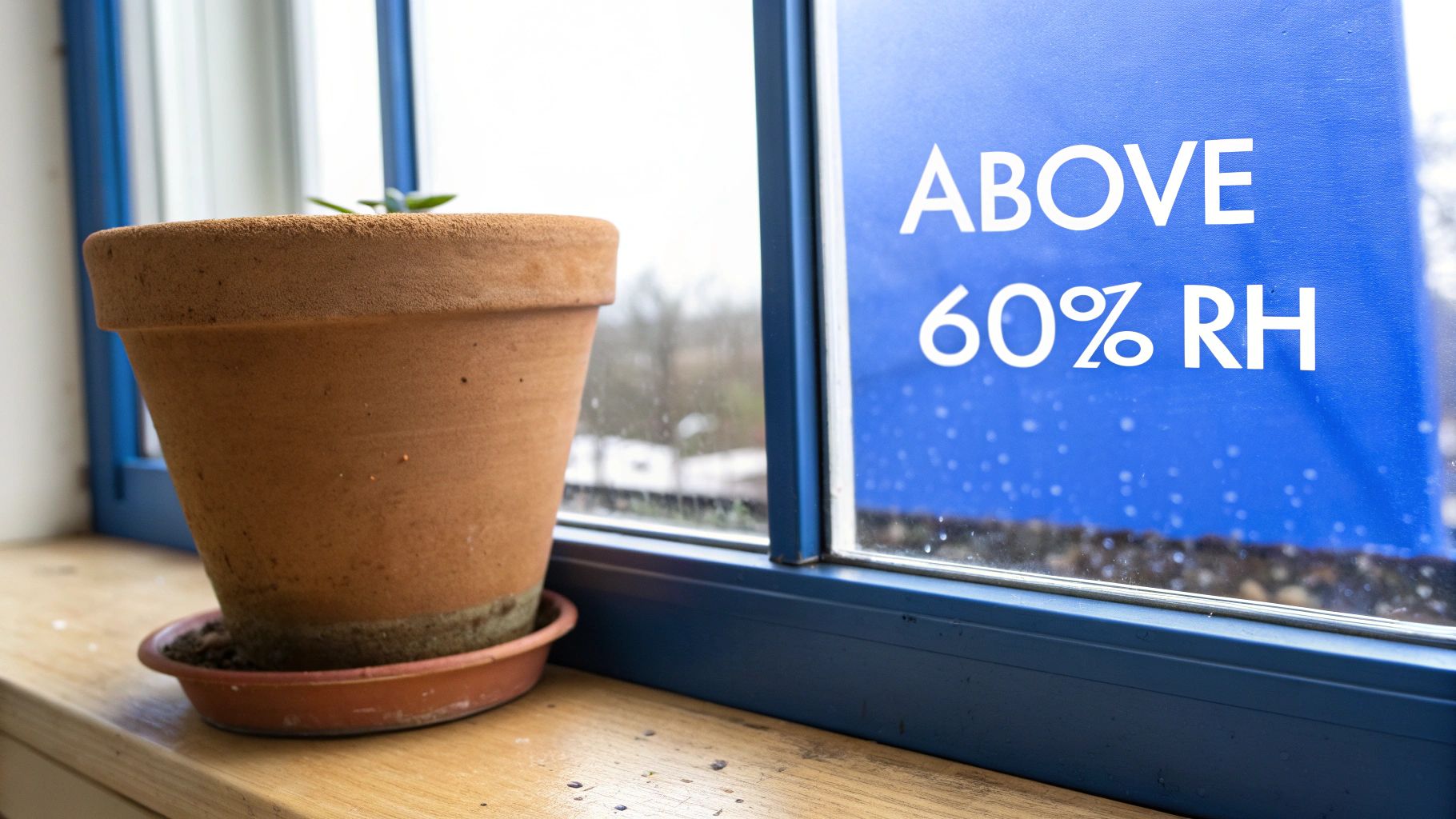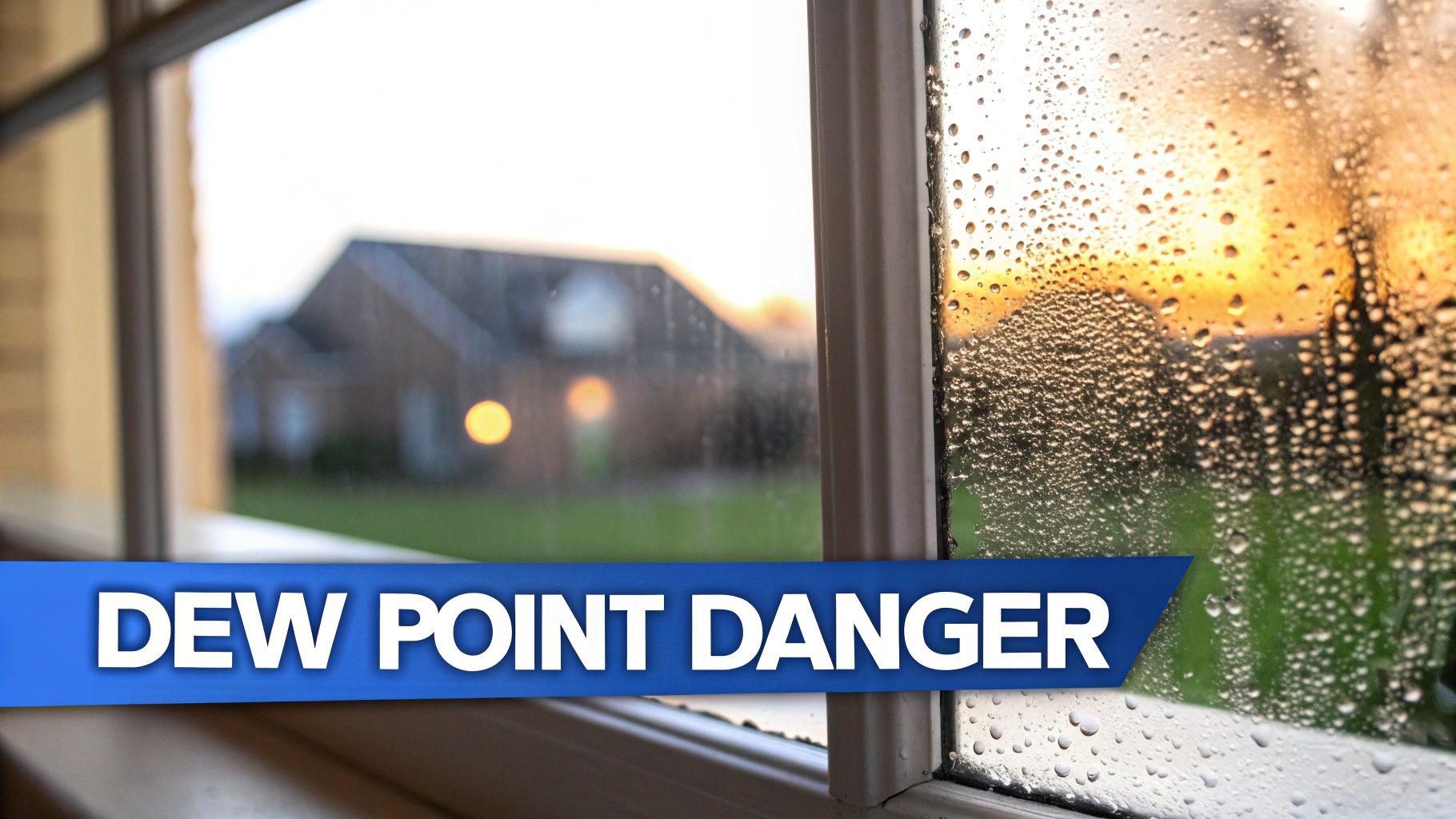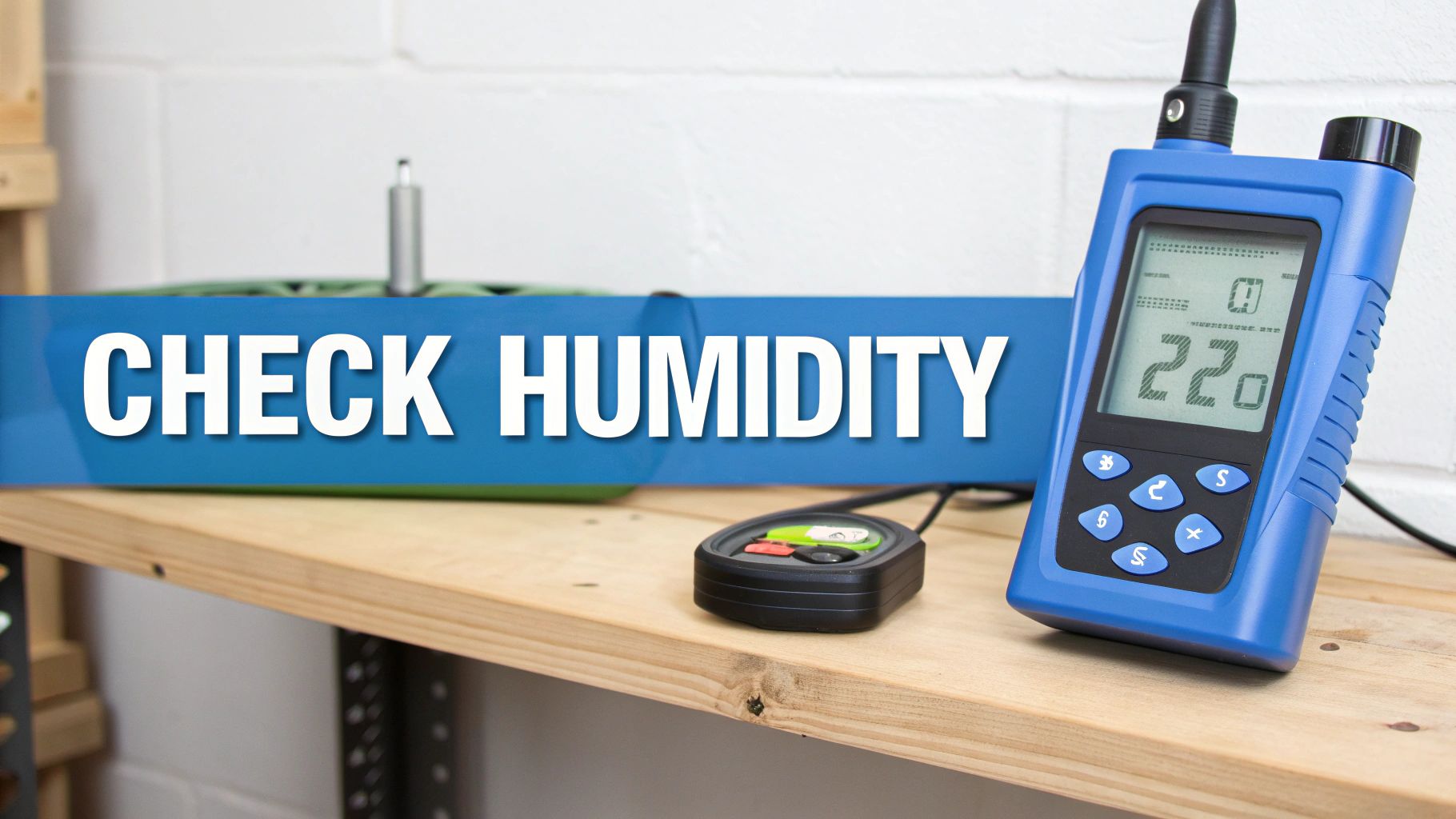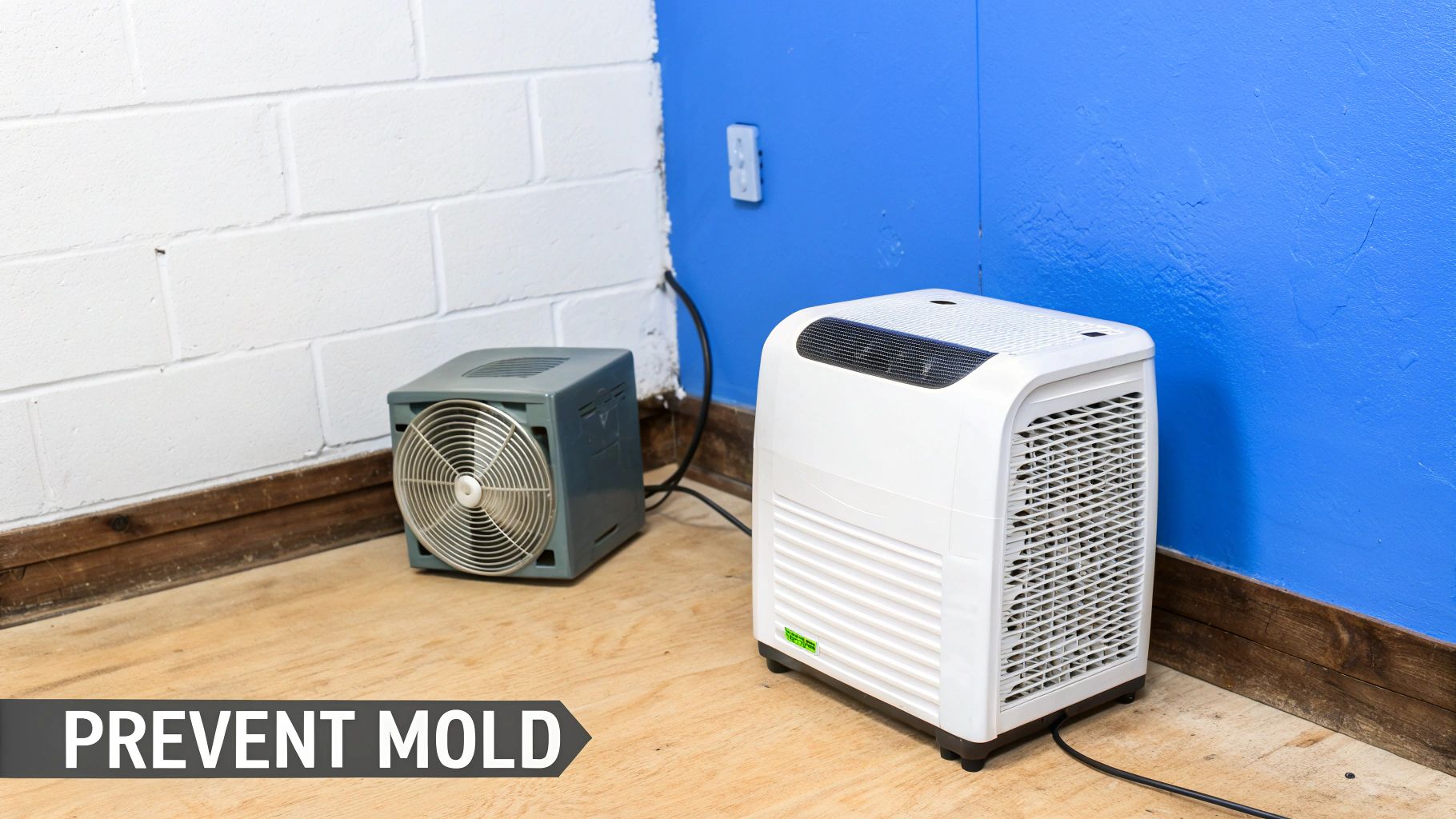You’ve probably heard that 60% relative humidity (RH) is the magic number for mold. But here’s the thing: that number is just the beginning of the story.
Your living room hygrometer might read a perfectly safe number, but that doesn’t tell you what’s happening inside your walls, under your floors, or in the forgotten corners of your attic. It's those hidden micro-climates that create the perfect breeding grounds for mold, and understanding them is the key to truly mold-proofing your home.
The Tipping Point for Mold Growth

Think of your home's building materials—drywall, wood, insulation—like a terracotta pot. Even when the air around it feels dry, the pot itself can absorb and hold onto moisture, staying damp long after you've watered the plant. This is exactly what happens inside your house. Those materials act like a sponge, creating a persistent source of moisture that mold spores absolutely love.
A hygrometer reading only gives you a snapshot of the moisture floating in the air. It can't tell you what's happening within those porous surfaces. This is why a room with a "safe" humidity level can still be hiding a serious mold problem just out of sight.
Why 60% Relative Humidity Is the Magic Number
So, at what humidity does mold really start to grow? That 60% RH mark is widely recognized as the threshold where dormant mold spores wake up, activate, and start to colonize. The U.S. Environmental Protection Agency (EPA) actually recommends keeping your indoor humidity even lower—ideally between 30% and 50%—to be safe.
But even below 60%, you’re not totally out of the woods. Mold can still pop up wherever moisture condenses on colder surfaces, like windows or poorly insulated walls. This is especially true in coastal California homes, where the cool marine air can easily find its way inside and settle in poorly ventilated areas.
The real danger isn't just the ambient humidity you can measure in the open air. It's the localized, high-humidity zones created by condensation and moisture trapped within building materials that provide the perfect conditions for mold to flourish undetected.
To give you a clearer picture, here’s a quick guide to what different humidity levels mean for your home.
Humidity Levels and Associated Mold Risk
This table breaks down the different indoor relative humidity ranges and the corresponding risk level for mold growth.
| Relative Humidity (RH) | Mold Growth Risk | Recommended Action |
|---|---|---|
| Below 30% | Very Low | May be too dry for comfort. Consider a humidifier if needed. |
| 30% – 50% | Ideal / Low | Maintain this level for a healthy, mold-resistant home. |
| 50% – 60% | Moderate | Growth is possible. Increase ventilation or use a dehumidifier. |
| Above 60% | High | Mold growth is likely. Take immediate action to reduce humidity. |
| Above 80% | Very High | Conditions are perfect for rapid mold colonization. |
Keeping an eye on these levels is a great first step, but remember that these are just general guidelines for the air in a room.
Understanding Your Home's Micro-Climates
Your home isn't a single, uniform environment. It's a collection of distinct micro-climates, each with its own temperature and humidity profile. It’s in these little pockets where trouble usually starts.
Here are a few common examples:
- Basements and Crawl Spaces: These spots are naturally cooler and often suffer from poor air circulation, making them magnets for moisture.
- Bathrooms without Proper Ventilation: Steam from a hot shower can quickly saturate the drywall and linger for hours, creating a perfect humid bubble.
- Attics with Poor Airflow: Wild temperature swings between day and night can cause condensation to form on the underside of the roof sheathing.
Even something as simple as a cold windowpane on a humid day can create a pocket of 100% relative humidity right on the glass. That’s more than enough water for mold to get started.
If you suspect these hidden moisture pockets are causing a musty smell or other issues, it might be time for a professional look. Services like a thorough mold inspection can pinpoint these problem areas before they escalate. A detailed assessment reveals the unseen threats that a simple hygrometer reading will always miss.
Why Humidity Is More Than Just a Number
Ever notice how a cold glass of iced tea “sweats” on a warm afternoon? That beading moisture is condensation, and the exact same thing is happening inside your home, creating hidden hotspots for mold. The humidity reading on your hygrometer only tells you part of the story; it’s the relationship between air temperature, surface temperature, and moisture that really determines your risk.
This is a dynamic you have to understand. Your living room might have a perfectly acceptable 50% relative humidity, but that warm, moist air is always on the move. When it drifts over and touches a colder surface—like a metal window frame, a poorly insulated exterior wall, or plumbing pipes in a cool crawlspace—the air cools down instantly.
This rapid cooling forces the air to let go of its moisture as liquid condensation, just like on your iced tea glass. This process is all about the dew point—the exact temperature at which air becomes 100% saturated and water droplets have no choice but to form.
The Dew Point Dilemma in Your Home
You don't need a massive leak for mold to find a water source. Condensation is often the silent culprit, providing a slow, steady drip of moisture in places you'd never think to look. It essentially creates tiny pockets of 100% humidity, even when the rest of the room feels perfectly dry.
This is a classic problem in coastal California homes, where the cool marine air can chill exterior-facing walls. Warm indoor air hits these cold surfaces, and condensation is born.
When the temperature of a surface drops to the dew point, it becomes a water source. This is how mold can thrive in a closet, behind a headboard against an outside wall, or under a window, despite a "safe" humidity reading in the room.
These hidden moisture zones are exactly where mold colonies love to start their quiet takeover.
Where Condensation Creates Mold Hotspots
So, where should you look for this sneaky moisture? Condensation doesn't just happen anywhere; it targets specific spots where there’s a big temperature difference. Be extra vigilant about checking these common problem areas:
- Window Panes and Frames: Especially single-pane or metal-framed windows that get chilly fast.
- Exterior Walls: Pay close attention to corners or spots behind large furniture where airflow is blocked.
- Plumbing Pipes: Cold water pipes running through warmer basements or crawl spaces are famous for "sweating."
- HVAC Vents and Ductwork: Poorly insulated ducts can condense moisture, leading to mold growth right inside your ventilation system.
Finding and fixing the root causes of these temperature gaps is the key. For a deeper dive, learning more about professional moisture intrusion solutions can give you a clear path forward. By getting these micro-climates under control, you can shut down mold's water supply before it ever has a chance to grow.
Pinpointing Your Home’s Hidden Moisture Sources
Understanding that condensation creates mold hotspots is one thing, but where does all that moisture come from in the first place? Often, the answer is closer than you think. Excess humidity doesn’t just materialize out of thin air; it’s usually generated by our daily routines, a few maintenance oversights, or even the way our homes are built.
Think of yourself as a detective in your own house. By identifying these sources, you can trace high humidity back to its origin and cut off moisture problems before they ever give mold a foothold. Let's break down the most common culprits.
Everyday Activities That Raise Humidity
You’d be surprised how much moisture a normal day adds to your indoor air. These activities are the most common contributors, especially in homes that are smaller or don’t have great airflow.
- Cooking and Boiling: Simmering a pot of pasta or boiling water for tea sends a massive amount of steam straight into your kitchen.
- Showering and Bathing: That long, hot shower feels great, but it can dramatically spike the humidity in your bathroom. Without a good fan, that moisture drifts into adjoining rooms.
- Breathing and Perspiring: Just being alive adds moisture to the air. A family of four can release several gallons of water vapor into their home’s atmosphere every single week just by breathing.
- Drying Clothes Indoors: Hanging wet laundry on a drying rack is a humidity-generating machine, releasing large volumes of water into the air as the clothes dry.
It’s easy to dismiss the steam from a single shower, but these small, daily events compound. Over time, they create a consistently humid environment that is perfect for mold colonization if ventilation is inadequate.
Hidden Maintenance and Structural Issues
While daily life adds its share of moisture, the bigger, more persistent problems often lurk behind the scenes. These issues can introduce water slowly and steadily, creating the kind of chronic dampness that mold absolutely loves. It's critical to be aware of these less obvious—but highly problematic—sources.
Common maintenance issues include:
- Slow Plumbing Leaks: That tiny, persistent drip under a sink or behind a toilet can go unnoticed for months, completely saturating drywall, cabinets, and flooring. It's a hidden oasis for mold.
- Clogged Gutters and Downspouts: When your gutters overflow, rainwater cascades down the side of the house, soaking the foundation and potentially seeping into basements or crawl spaces.
- Inefficient Appliance Venting: Dryer vents that are clogged or improperly installed can pump warm, moist air directly into your walls or attic instead of safely outside.
Beyond simple repairs, structural flaws can create permanent pathways for moisture to enter. Cracks in the foundation can allow groundwater to seep in, while poor attic ventilation can trap hot, humid air, leading to condensation on the underside of your roof sheathing.
The crawl space is another notoriously problematic area, often suffering from high humidity as moisture evaporates from the ground below. Understanding and addressing potential moisture problems in your crawl space is absolutely essential for maintaining a healthy home from the ground up.
How to Accurately Measure Your Home's Humidity
You can't fight what you can't see. To get a real handle on the moisture levels in your home—the very conditions that invite mold to grow—you need the right tools. Your best friend in this battle is a hygrometer, a simple device that measures relative humidity.
Digital hygrometers are the way to go. They’re generally more accurate than the old analog dials and give you a precise, real-time number, taking all the guesswork out of monitoring your home's indoor climate. But just having one isn't enough; knowing where to put it is what turns a simple number into a powerful preventative tool.
Strategic Placement for Meaningful Readings
Sticking a single hygrometer in your hallway will give you a ballpark idea of your home's average humidity, but it won’t flag the real trouble spots. Mold loves to hide out in microclimates, those little pockets of high moisture, so you need to measure those specific areas to get the full story.
To get a truly comprehensive picture, place a few hygrometers in these key locations:
- Basements and Crawl Spaces: These below-ground areas are naturally prone to dampness and are prime real estate for mold.
- Bathrooms: Place one away from the showerhead to track how quickly the humidity clears out after you’ve steamed up the room.
- Attics: Temperature swings in an attic can create condensation and moisture problems you’d never notice otherwise.
- Near Large Windows: This is a great way to check if condensation on the glass is creating a localized high-humidity zone on the sill or surrounding wall.
A quick pro tip: Don’t place your hygrometer in direct sunlight, right next to a heating vent, or in the kitchen while you’re boiling pasta. These will give you skewed, temporarily high readings that don’t reflect the room’s true, baseline humidity.
Going Beyond the Air with a Moisture Meter
While a hygrometer tells you what's happening in the air, a moisture meter lets you see what’s going on inside your walls, floors, and other building materials. This is the next level of investigation, helping you find hidden water damage that isn't visible on the surface.
This tool uses a couple of small probes to measure electrical resistance. Since water is a great conductor, lower resistance means higher moisture content. It's the perfect way to confirm if that musty smell is actually coming from a damp wall or to check if an old ceiling stain is still actively wet.
Remember, keeping humidity low is one of your most powerful weapons. In a study on Cladosporium cladosporioides, a common indoor mold, researchers found that spore survival dropped dramatically at 40% RH. In contrast, the spores thrived at 60% and 80% RH. This science backs up what we see in the field every day: consistent humidity control is your single most effective strategy for preventing mold. You can learn more about this research from the full scientific study on mold spore survival.
Your Proactive Plan for Preventing Mold
Understanding the science behind mold is one thing, but putting that knowledge into practice is what truly protects your home. The good news is that creating an environment where mold simply can't get a foothold doesn't require a massive overhaul. It’s all about a proactive strategy built on a few core principles.
By getting ahead of moisture at its source, boosting your home’s airflow, and managing indoor temperatures, you can take real control of your indoor climate. This is especially true during our warmer, humid seasons when outdoor humidity often climbs above 60%—perfect weather for mold. That humidity fuels the "mold growth triangle" of warmth, moisture, and food, letting it spread fast. The goal is to keep your indoor humidity between a healthy 30% and 50%.
Control Moisture at Its Source
Honestly, the most powerful way to stop mold is to cut off its water supply before it ever has a chance to accumulate. This means being mindful of the everyday activities and systems that pump water vapor into your home's air. A few simple habits and routine checks can make a world of difference.
- Ventilate, Ventilate, Ventilate: Always run the exhaust fans in your bathrooms during and after showers. Do the same in the kitchen when you're cooking. Make sure your clothes dryer vents directly outside and that the vent line is clear of lint buildup.
- Fix Leaks Immediately: That tiny drip under the sink or the slow seep around a window frame might seem harmless, but it’s a constant, reliable water source for mold. Jump on any plumbing or roof leaks right away.
Improve Air Circulation and Ventilation
Stagnant, humid air is a mold spore’s best friend. When air doesn’t move, moisture settles on surfaces and creates the perfect little microclimates where mold loves to hide and grow. Think of it as giving your home a chance to breathe.
Getting good circulation is easier than you think:
- Use Fans Strategically: Run ceiling fans or even place a small portable fan in damp-prone areas like basements to keep the air from getting heavy and still.
- Avoid Clutter: Leave a few inches of space between your furniture and exterior walls. This simple trick prevents condensation from getting trapped behind a dresser or headboard, which is a classic spot for mold to start.
- Open Windows When Possible: On dry, less humid days, opening up the windows is a totally free and incredibly effective way to swap out stale, moist indoor air for fresh, dry air.
Don't underestimate the power of airflow. Even a small fan can disrupt the still, damp conditions necessary for mold to colonize on a surface, effectively stopping an infestation before it begins.
Manage Ambient Humidity with Dehumidifiers
For those areas with stubborn humidity—like basements, crawl spaces, or during our damp coastal seasons—a dehumidifier is your most reliable tool. These machines actively pull moisture from the air, helping you lock in that ideal 30% to 50% relative humidity range.
When you're shopping for one, match the model’s capacity to the square footage of the room. I highly recommend getting one with a built-in humidistat; it will automatically cycle on and off to maintain your target humidity level. This way, you aren't just guessing—you're actively preventing the conditions mold needs to grow.
Of course, even with the best game plan, life happens. For what to do after a flood or major leak, our guide on how to prevent mold after water damage offers some critical, time-sensitive advice.
When to Call in the Pros for Mold Remediation
While staying on top of moisture is your best defense against mold, some situations just aren't cut out for a DIY approach. Knowing when to put down the sponge and call a certified professional isn't giving up; it's the smartest move you can make to protect your home and your family's health. Recognizing these red flags early can save you from a much bigger, more expensive headache down the road.
If you’ve stumbled upon a patch of mold larger than 10 square feet—that’s roughly a 3×3 foot area—it's time to call for backup. This isn't just a suggestion; the EPA strongly recommends professional help for any job of this size. Why? The risk of accidentally spreading mold spores throughout your home skyrockets. Disturbing a large colony without the right containment gear can release millions of spores into the air you breathe.
Signs That Demand an Expert Eye
Sometimes, the most serious mold problems are the ones you can't even see. Your own senses are often the best first alert system, picking up on clues that require professional tools to fully uncover. Be on high alert for these subtle but serious signs of a hidden mold issue.
- A Persistent Musty Smell: If you keep smelling that distinct, earthy, damp odor but can't find a source, it’s a huge indicator that a colony is thriving out of sight—behind your walls, under the floorboards, or tucked away in the attic.
- Unexplained Allergy-Like Symptoms: Are you or your family members suddenly dealing with chronic coughing, sneezing, watery eyes, or other allergy symptoms that seem to get better when you leave the house? This is a classic sign of inhaling mold spores from an unseen source.
A professional inspection goes far beyond what the naked eye can see. We use tools like thermal imaging cameras and moisture meters to detect hidden moisture and active mold growth inside your walls without having to tear anything apart. This technology allows for a precise, effective remediation plan from the very start.
At the end of the day, professionals do more than just clean up mold. They perform a complete remediation, which means they find the root cause of the moisture, contain the affected area to prevent cross-contamination, and safely remove all contaminated materials for good.
To really grasp the difference, check out our guide on mold removal vs. remediation. It breaks down why a thorough, professional process is absolutely essential for a permanent solution. When in doubt, getting a professional assessment is the surest way to get the answers and peace of mind you need.
Got Questions? We've Got Answers
When you're dealing with potential mold, a lot of questions come up. It's easy to get conflicting information online, so let's clear the air on some of the most common myths and challenges homeowners face.
Will a Dehumidifier Get Rid of My Mold?
This is a great question, and the answer is a firm no. A dehumidifier is a fantastic tool for prevention, but it's not a cure for an existing mold problem.
Think of it this way: a dehumidifier makes the environment less welcoming for future mold growth by pulling moisture out of the air. But it does absolutely nothing to remove the mold colonies that are already there. You have to physically remove the mold first, and then use the dehumidifier to help keep it from coming back.
I Heard Mold Dies if You Dry It Out. Is That True?
This is one of the most dangerous misconceptions out there. When mold loses its water source, it doesn't die—it just goes dormant.
These inactive spores are like tiny, resilient seeds just waiting for the next leak, spill, or humid day to spring back to life. The only way to truly solve the problem is through complete physical removal of the contaminated materials. Don't let dormant mold fool you into a false sense of security.
Is a Little Mold in the Shower Normal?
Seeing some minor mildew on your shower grout is pretty common, and you can usually keep it in check with regular cleaning and good ventilation (like running the fan).
However, you should pay close attention if you see dark, fuzzy spots spreading beyond the grout lines onto the walls or ceiling. A persistent musty smell that doesn't go away is another red flag. These signs often point to a bigger issue, like a hidden pipe leak or ventilation that just isn't cutting it.


